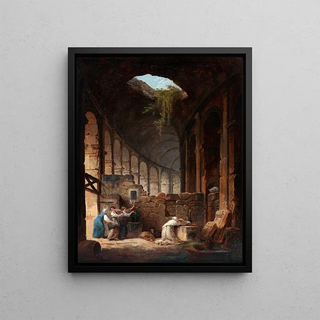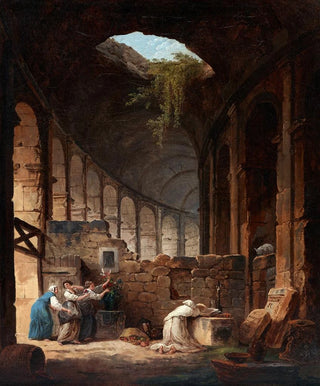Art print | Hermit in the Colosseum - Hubert Robert


View from behind

Frame (optional)
Art print of Hermit in the Colosseum - Hubert Robert – Captivating introduction
In the fascinating universe of art, some works emerge as silent witnesses to history and collective imagination. "Hermit in the Colosseum" by Hubert Robert is one of those creations that capture the essence of an era while inviting contemplation. This canvas, where the majesty of Roman ruins and the solitude of a hermit intertwine, transports the viewer on a journey through time. The soft light bathing the scene, the architectural details of the Colosseum, and the isolated human figure offer a rich tableau of emotions and reflections. Through this work, Robert does not merely depict an iconic place; he also evokes universal themes such as solitude, nature, and the passage of time.
Style and uniqueness of the work
Hubert Robert's work stands out for its unique approach to landscapes and ruins. In "Hermit in the Colosseum," the artist employs a palette of warm, natural colors that create a serene and contemplative atmosphere. The contrast between the grandeur of ancient structures and the fragility of the human figure highlights the ephemeral beauty of existence. Robert excels in depicting the play of light, which lends his compositions an almost dreamlike quality. The Colosseum, a symbol of Rome's power, is presented here not as a glorious monument but as a space for meditation, where nature reclaims its rights. The meticulous details of the vegetation thriving in the cracks of the stones testify to nature's resilience in the face of human work. This stylistic choice makes this canvas a work of great depth, inviting reflection on the relationship between man and his environment.
The artist and his influence
Hubert Robert, born in 1733, was a French painter whose work is often associated with the neoclassical movement. Trained at the Royal Academy of Painting and Sculpture, Robert was deeply influenced by his travels in Italy, where he admired the vestiges of Antiquity. His work reflects a fascination with ruins and landscapes, developing a style that blends reality and imagination. As a precursor of the Romantic landscape, he

Matte finish

View from behind

Frame (optional)
Art print of Hermit in the Colosseum - Hubert Robert – Captivating introduction
In the fascinating universe of art, some works emerge as silent witnesses to history and collective imagination. "Hermit in the Colosseum" by Hubert Robert is one of those creations that capture the essence of an era while inviting contemplation. This canvas, where the majesty of Roman ruins and the solitude of a hermit intertwine, transports the viewer on a journey through time. The soft light bathing the scene, the architectural details of the Colosseum, and the isolated human figure offer a rich tableau of emotions and reflections. Through this work, Robert does not merely depict an iconic place; he also evokes universal themes such as solitude, nature, and the passage of time.
Style and uniqueness of the work
Hubert Robert's work stands out for its unique approach to landscapes and ruins. In "Hermit in the Colosseum," the artist employs a palette of warm, natural colors that create a serene and contemplative atmosphere. The contrast between the grandeur of ancient structures and the fragility of the human figure highlights the ephemeral beauty of existence. Robert excels in depicting the play of light, which lends his compositions an almost dreamlike quality. The Colosseum, a symbol of Rome's power, is presented here not as a glorious monument but as a space for meditation, where nature reclaims its rights. The meticulous details of the vegetation thriving in the cracks of the stones testify to nature's resilience in the face of human work. This stylistic choice makes this canvas a work of great depth, inviting reflection on the relationship between man and his environment.
The artist and his influence
Hubert Robert, born in 1733, was a French painter whose work is often associated with the neoclassical movement. Trained at the Royal Academy of Painting and Sculpture, Robert was deeply influenced by his travels in Italy, where he admired the vestiges of Antiquity. His work reflects a fascination with ruins and landscapes, developing a style that blends reality and imagination. As a precursor of the Romantic landscape, he






